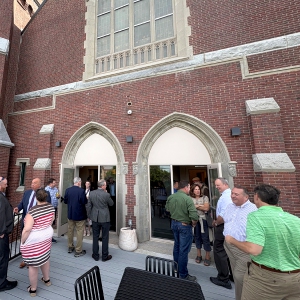Toot toot, not hoot hoot
| Published: 03-17-2021 8:56 PM |
During a recent evening trip to the shed to fetch some firewood, I heard a strange sound in the woods. I recognized the sound but listened intently to be sure I was hearing what I thought I was hearing. It resembled a truck backing up, but we live in a fairly rural area and there are no roads nearby in the direction of the sound.
If you go to an app or a website that has recordings of bird sounds or read in a field guide about the call of the saw-whet owl, you’ll learn that it does not hoot like some of the larger owls. Its “song” is a high-pitched toot-toot-toot or beep-beep-beep, with about two notes per second, like the backup warning of a truck or bus.
When I came inside, I logged on to my favorite bird identification website (allaboutbirds.org) and played the recording of the saw-whet – just as I thought, it was exactly like what I’d heard outside. I was thrilled. I keep an annual “yard list” of bird species that live or pass through our property, but in 15 years, the saw-whet had not been on that list.
Saw-whet owls are fairly common in New Hampshire. Yet partly due to their size, they are inconspicuous and rarely seen. As New Hampshire’s smallest owl, they measure just eight inches tall with a wing-span of about 19 inches. Being nocturnal is another reason why people don’t often see them.
When they are located, it may be due to a ruckus caused by songbirds that are mobbing them. One of the few times I’ve seen a saw-whet was thanks to a group of chickadees that was scolding it. I peered between the branches of a white pine tree and there, tucked in next to the trunk was a diminutive owl. Its brown feathers, streaked with white, are effective camouflage, but it's bright yellow eyes glared back at me with a piercing brightness.
Despite its size, it is a predator and though mice and small mammals make up most of its diet, the saw-whet will occasionally eat insects and songbirds. The chickadees were clearly feeling threatened.
Its sound is probably another reason why the saw-whet is not often noticed. When I shared the story of my encounter, most friends (the non-birders at least) were shocked to learn that the sound I described came from an owl. They, like many people, associate owls with a hooting sound.
The much larger and commonly heard barred owl does have a distinctive hoot pattern “who cooks for you, whoooo cooks of you awwwl” is how its sound is paraphrased. The great-horned owl has the most classic deep and booming “whoo whoo whoo-whoo” call. These sounds pierce the night air and carry quite a distance. But the high, thin too-toot song, or as the old timers described it, the sound of whetting or sharpening a saw, (hence the owl’s name) is only heard at closer range, not more than a half a mile.
Article continues after...
Yesterday's Most Read Articles
 Bow offers water to Hooksett plant, asks Concord to help fix its supply
Bow offers water to Hooksett plant, asks Concord to help fix its supply
 New Concord apartments open in former First Congregational Church
New Concord apartments open in former First Congregational Church
 Goodwell Foods takes over Rustic Crust private label frozen pizza
Goodwell Foods takes over Rustic Crust private label frozen pizza
 St. Paul’s School won’t reopen public access to Turkey Pond
St. Paul’s School won’t reopen public access to Turkey Pond
 Concord Christian Academy celebrates accomplishment and faith at graduation ceremony
Concord Christian Academy celebrates accomplishment and faith at graduation ceremony
 Inside EFAs: How school vouchers have fueled an enrollment boom at Christian schools across New Hampshire
Inside EFAs: How school vouchers have fueled an enrollment boom at Christian schools across New Hampshire
There are other sounds that the saw-whet makes as well, also not what people think of when they imagine an owl. The whines, squeaks and high-pitched barks are even less commonly heard.
The saw-whet can be found in New Hampshire at any time of year but some do migrate. Like many of the year-round species that we see (blue jays, robins, finches) some individuals that we see in the winter may have come from further north, while the breeders of our region travel to slightly warmer zones.
When it is time to breed (mid-March in our area), these pint-sized predators use a cavity in a tree to lay their 4 to 7 eggs and raise their young. The owls don’t have the tools to excavate a cavity so rely on old woodpecker holes or tree wounds that may have been chewed open by squirrels. They will also use human-made nest boxes of proper proportions (for building and placement instructions see tinyurl.com/483jws63).
Knowing the importance of cavities for owls and other species, we always leave some dead trees standing when we harvest our firewood. Maybe this saw-whet owl will find one to its likely and stick around. That would be a hoot, I mean a toot!
]]>







 Vintage Views: The Liars Club
Vintage Views: The Liars Club Two Villages Art Society begins summer members show
Two Villages Art Society begins summer members show Artist Spotlight: Brittany Batchelder
Artist Spotlight: Brittany Batchelder Young Professional of the Month Katie Duncan shares about creativity, community, connection
Young Professional of the Month Katie Duncan shares about creativity, community, connection
